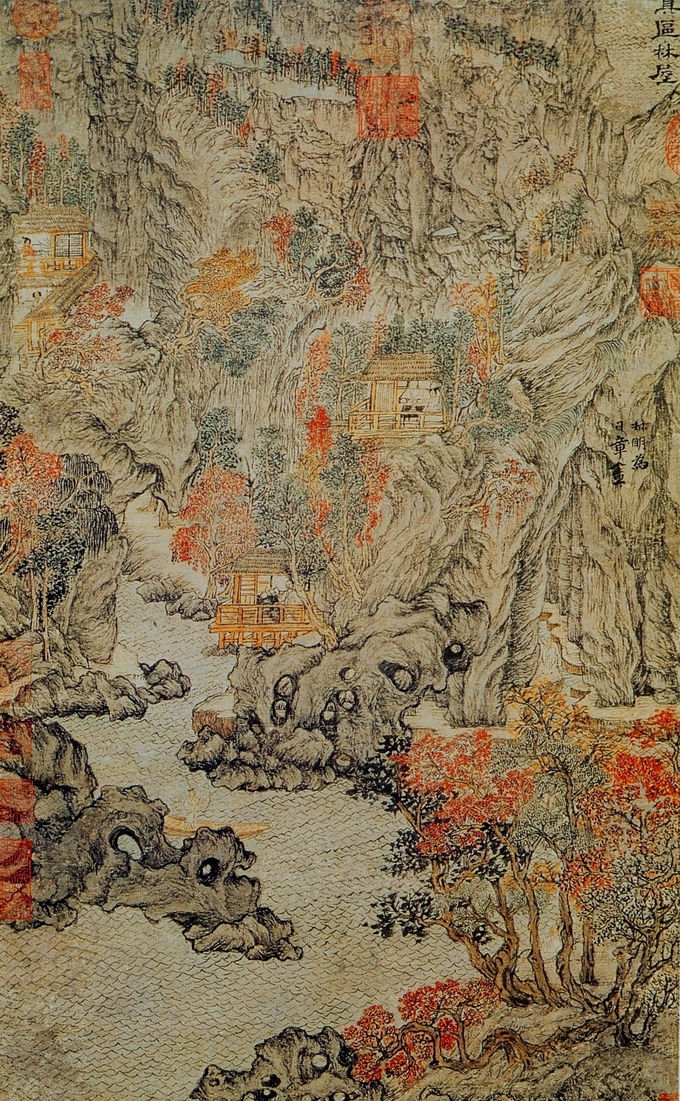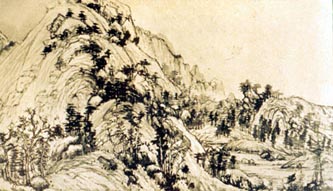12.2: The Yuan Dynasty
- Page ID
- 53088
Painting under the Yuan Dynasty
The Yuan Dynasty (1271–1368) saw the consolidation of poetry, painting, and calligraphy into a unified canon of classical Chinese art.
Learning Objectives
Discuss the fusion of styles in painting during the Yuan Dynasty, as well as the influencial artists who returned to the “blue and green” landscape style
Key Takeaways
Key Points
- The Yuan Dynasty was a time of important developments in the areas of painting, calligraphy , poetry, and theater, with many great artists practicing more than one medium .
- With the Yuan Dynasty, many artists retreated from social life and returned to nature through landscape paintings.
- Wang Meng was a leading painter of the Yuan Dynasty, and one of his most famous works is the Forest Grotto.
- Zhao Mengfu was a Chinese scholar, painter, and calligrapher who rejected the refined, gentle brushwork of his era in favor of the cruder style of the 8th century; he is considered to have brought about a revolution that created the modern Chinese landscape painting.
- Among the Yuan Dynasty artists, there were also the vivid and detailed works by Qian Xuan, who was famous for reviving and reproducing a more Tang Dynasty style of painting.
- The later Yuan Dynasty is characterized by the work of the so-called “Four Great Masters,” including Huang Gongwang, whose cool and restrained landscapes were admired by contemporaries and by the Chinese literati painters of later centuries.
Key Terms
- Wang Meng: (c. 1308–1385) A Chinese painter of the Yuan Dynasty who famously refused to serve the Mongolian rulers of their country.
- Yuan Dynasty: The empire established by Kublai Khan, the leader of the Mongolian Borjigin clan, after the Mongols conquered the Jin and Southern Song Dynasty in China; lasting from 1271 to 1368.
- Zhao Mengfu: (1254–1322) A Chinese prince and descendant of the Song Dynasty’s imperial family, and a scholar, painter, and calligrapher during the Yuan Dynasty.
Overview: The Yuan Dynasty (1271–1368)
With the fall of the Song Dynasty in 1279 and the subsequent dislocation caused by the establishment of the Yuan Dynasty by the Mongol conquerors, many court and literary artists retreated from social life. This was a time of important developments in the areas of painting, calligraphy, poetry, and theater, with many great artists practicing more than one medium. A great deal of artwork of the Yuan Dynasty has survived in China, relative to works from the Tang Dynasty and Song Dynasties, which have often been better preserved in places such as the Shōsōin in Japan.
Painting, Calligraphy, Poetry, and Theatre
One of the important cultural developments during the Yuan era was the consolidation of poetry, painting, and calligraphy into a unified piece that tends to come to mind when people think of classical Chinese art. The Song Dynasty and the Yuan Dynasty are linked together through the development of landscape painting, as well as the classical joining of calligraphy and poetry. In Yuan poetry, qu was the main development, which was used among other poetic forms by most of the famous Yuan poets. The qu form of poetry consists of words written in one of a number of certain, set tone patterns, based upon the tunes of various songs.
Many of the poets were also involved in the major developments in the theater during this time. Zazu was a form of Chinese drama or opera that provided entertainment through a synthesis of recitations of prose and poetry, dance, singing, and mime, with a certain emphasis on comedy or happy endings. One of the key factors in the common zaju variety shows was the incorporation of poetry both classical and of the newer qu form.
Influential Artists
Wang Meng was a famous painter of the Yuan Dynasty, and one of his most famous works is the Forest Grotto. Zhao Mengfu was a Chinese scholar, painter, and calligrapher, whose rejection of the refined, gentle brushwork of his era in favor of the cruder style of the 8th century is considered to have brought about a revolution that created the modern Chinese landscape painting. There was also the vivid and detailed works of art by Qian Xuan (1235–1305), who had served the Song court and out of patriotism refused to serve the Mongols. Instead, Qian Xuan turned to painting and became famous for his return to nature through landscape painting and his renewal of the “blue and green” style of the Tang Dynasty.

Forest Grotto in Juqu by Wang Meng (1378): Wang Meng and the great masters of the Yuan Dynasty exclusively painted landscapes, which they believed to be the visible key to the invisible reality.
The later Yuan Dynasty is characterized by the work of the so-called “Four Great Masters.” The most notable of these was Huang Gongwang (1269–1354), whose cool and restrained landscapes were admired by contemporaries and by the Chinese literati painters of later centuries. Another man of great influence was Ni Zan (1301–1374), who frequently arranged his compositions with a strong and distinct foreground and background, leaving the middle ground as an empty expanse. This scheme was frequently adopted by later Ming and Qing Dynasty painters.

Dwelling in the Fuchun Mountains by Huang Gongwang (c. 1350): Huang Gongwang rejected the landscape conventions of his era’s Academy but is regarded as one of the great literati painters.
- Curation and Revision. Provided by: Boundless.com. License: CC BY-SA: Attribution-ShareAlike
- Wang Meng.nForest Grotto in Juqu.n1378.n68,8x42,5 National Palace Museum Taipei. Provided by: Wikipedia. Located at: en.Wikipedia.org/wiki/File:Wang_Meng._Forest_Grotto_in_Juqu._1378._68,8x42,5_National_Palace_Museum_Taipei.jpg. License: Public Domain: No Known Copyright
- DwellingInTheFuchun. Provided by: Wikipedia. Located at: en.Wikipedia.org/wiki/File:DwellingInTheFuchun.jpg. License: Public Domain: No Known Copyright
- Chinese art. Provided by: Wikipedia. Located at: en.Wikipedia.org/wiki/Chinese_art%23Yuan_painting. License: CC BY-SA: Attribution-ShareAlike
- Yuan Dynasty. Provided by: Wikipedia. Located at: en.Wikipedia.org/wiki/Yuan_Dynasty%23Culture. License: CC BY-SA: Attribution-ShareAlike
- Yuan Dynasty. Provided by: Wikipedia. Located at: en.Wikipedia.org/wiki/Yuan_Dynasty%23Culture. License: CC BY-SA: Attribution-ShareAlike
- Zhao Mengfu. Provided by: Wikipedia. Located at: en.Wikipedia.org/wiki/Zhao%20Mengfu. License: CC BY-SA: Attribution-ShareAlike
- Yuan Dynasty. Provided by: Wikipedia. Located at: en.Wikipedia.org/wiki/Yuan%20Dynasty. License: CC BY-SA: Attribution-ShareAlike
- Wang Meng. Provided by: Wikipedia. Located at: en.Wikipedia.org/wiki/Wang%20Meng. License: CC BY-SA: Attribution-ShareAlike

